Business Strategy Report: Analyzing Tesco's Competitive Advantage
VerifiedAdded on 2020/11/12
|13
|3914
|196
Report
AI Summary
This report provides a comprehensive analysis of Tesco's business strategy. It begins with an introduction to business strategies and their importance in achieving competitive advantage, using Tesco Plc as a case study. The report examines the impact of macro-environmental factors on Tesco using PESTEL analysis, covering political, economic, social, technological, environmental, and legal aspects. It then delves into the internal environment, analyzing Tesco's strengths, weaknesses, opportunities, and threats through a SWOT analysis, followed by a VRIO analysis to assess its sustainable competitive advantages. Furthermore, the report applies Porter's Five Forces model to evaluate the competitive landscape, assessing existing rivalry, the bargaining power of suppliers and buyers, the threat of new entrants, and the threat of substitutes. The report concludes with a summary of findings and references.
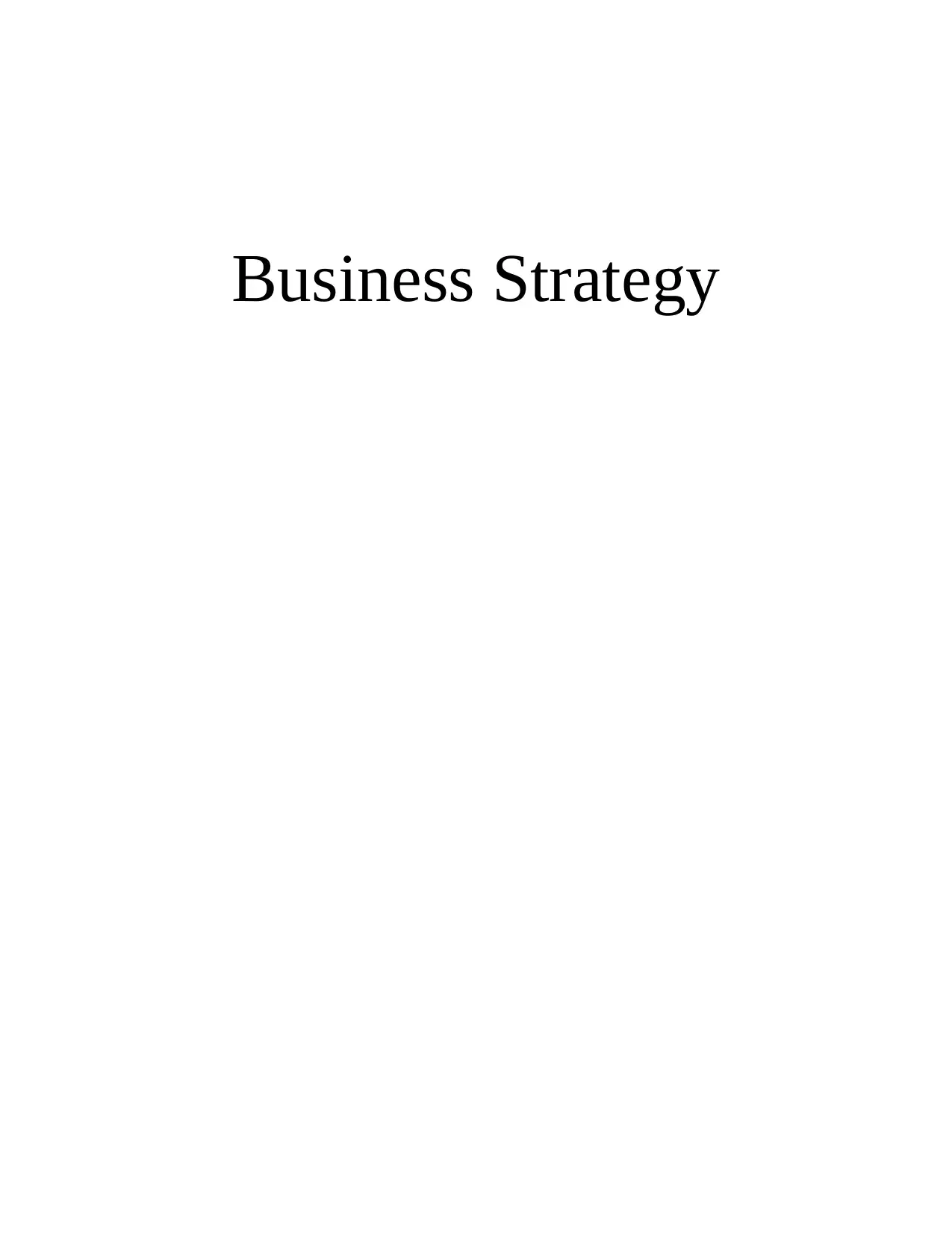
Business Strategy
Paraphrase This Document
Need a fresh take? Get an instant paraphrase of this document with our AI Paraphraser
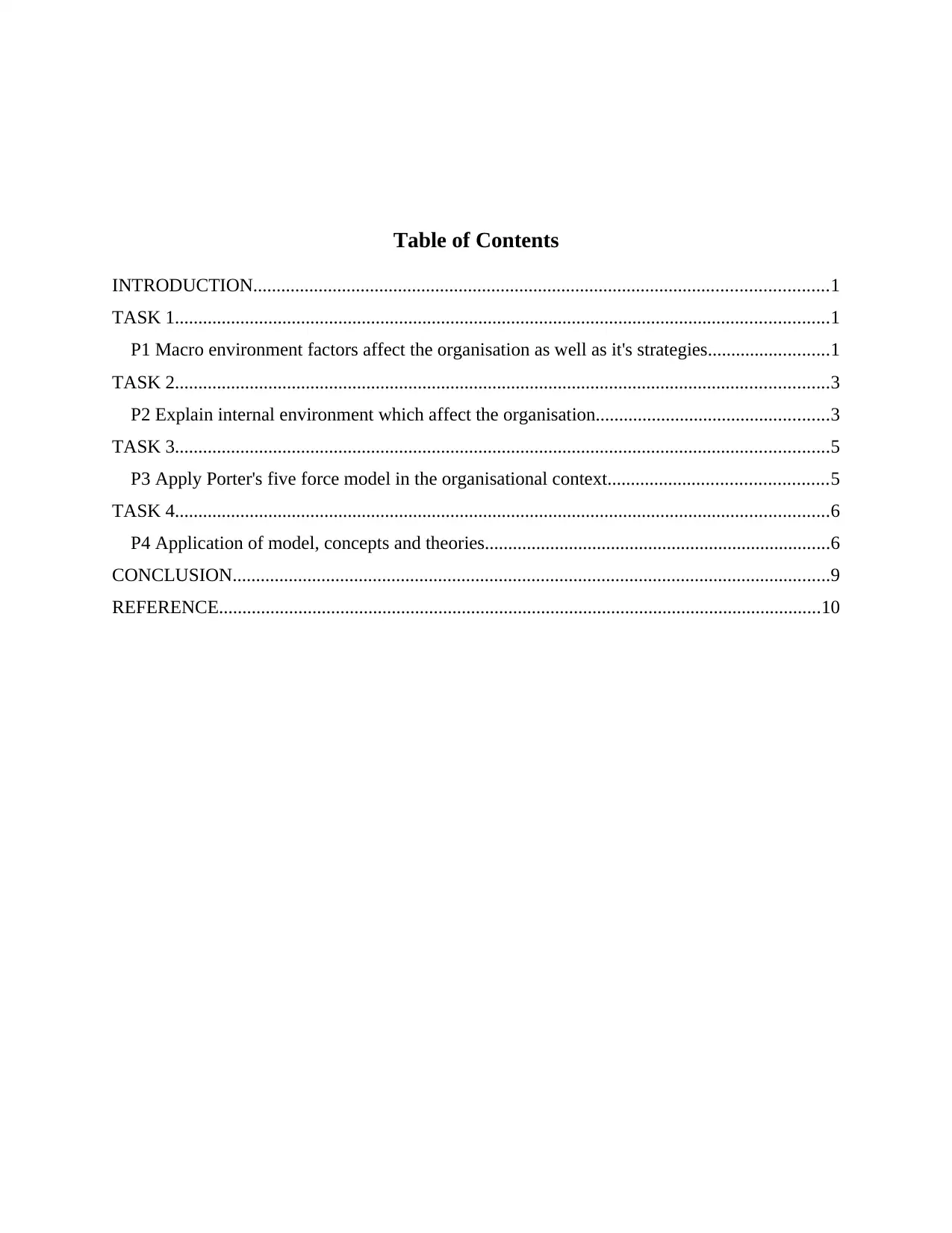
Table of Contents
INTRODUCTION...........................................................................................................................1
TASK 1............................................................................................................................................1
P1 Macro environment factors affect the organisation as well as it's strategies..........................1
TASK 2............................................................................................................................................3
P2 Explain internal environment which affect the organisation..................................................3
TASK 3............................................................................................................................................5
P3 Apply Porter's five force model in the organisational context...............................................5
TASK 4............................................................................................................................................6
P4 Application of model, concepts and theories..........................................................................6
CONCLUSION................................................................................................................................9
REFERENCE.................................................................................................................................10
INTRODUCTION...........................................................................................................................1
TASK 1............................................................................................................................................1
P1 Macro environment factors affect the organisation as well as it's strategies..........................1
TASK 2............................................................................................................................................3
P2 Explain internal environment which affect the organisation..................................................3
TASK 3............................................................................................................................................5
P3 Apply Porter's five force model in the organisational context...............................................5
TASK 4............................................................................................................................................6
P4 Application of model, concepts and theories..........................................................................6
CONCLUSION................................................................................................................................9
REFERENCE.................................................................................................................................10

⊘ This is a preview!⊘
Do you want full access?
Subscribe today to unlock all pages.

Trusted by 1+ million students worldwide
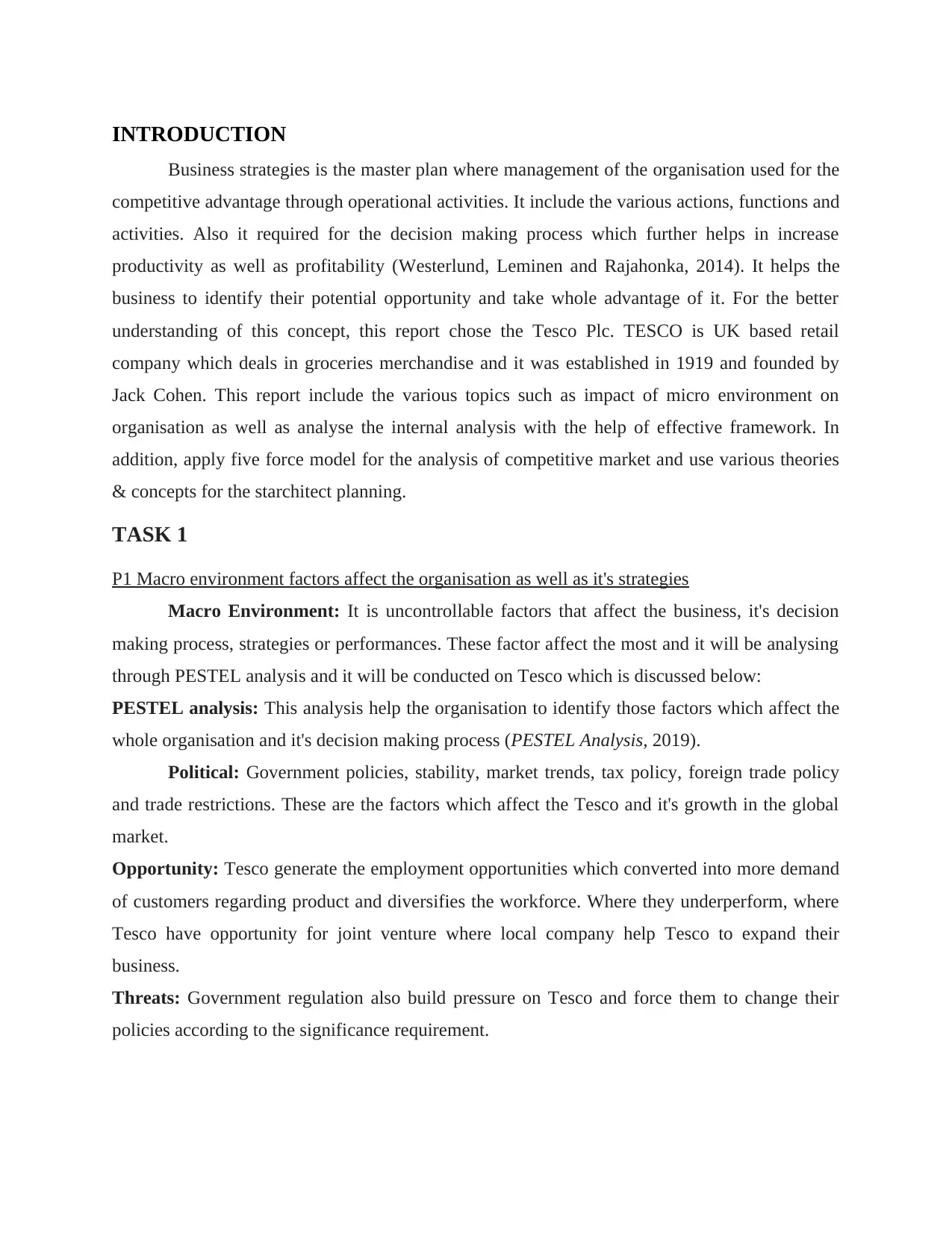
INTRODUCTION
Business strategies is the master plan where management of the organisation used for the
competitive advantage through operational activities. It include the various actions, functions and
activities. Also it required for the decision making process which further helps in increase
productivity as well as profitability (Westerlund, Leminen and Rajahonka, 2014). It helps the
business to identify their potential opportunity and take whole advantage of it. For the better
understanding of this concept, this report chose the Tesco Plc. TESCO is UK based retail
company which deals in groceries merchandise and it was established in 1919 and founded by
Jack Cohen. This report include the various topics such as impact of micro environment on
organisation as well as analyse the internal analysis with the help of effective framework. In
addition, apply five force model for the analysis of competitive market and use various theories
& concepts for the starchitect planning.
TASK 1
P1 Macro environment factors affect the organisation as well as it's strategies
Macro Environment: It is uncontrollable factors that affect the business, it's decision
making process, strategies or performances. These factor affect the most and it will be analysing
through PESTEL analysis and it will be conducted on Tesco which is discussed below:
PESTEL analysis: This analysis help the organisation to identify those factors which affect the
whole organisation and it's decision making process (PESTEL Analysis, 2019).
Political: Government policies, stability, market trends, tax policy, foreign trade policy
and trade restrictions. These are the factors which affect the Tesco and it's growth in the global
market.
Opportunity: Tesco generate the employment opportunities which converted into more demand
of customers regarding product and diversifies the workforce. Where they underperform, where
Tesco have opportunity for joint venture where local company help Tesco to expand their
business.
Threats: Government regulation also build pressure on Tesco and force them to change their
policies according to the significance requirement.
Business strategies is the master plan where management of the organisation used for the
competitive advantage through operational activities. It include the various actions, functions and
activities. Also it required for the decision making process which further helps in increase
productivity as well as profitability (Westerlund, Leminen and Rajahonka, 2014). It helps the
business to identify their potential opportunity and take whole advantage of it. For the better
understanding of this concept, this report chose the Tesco Plc. TESCO is UK based retail
company which deals in groceries merchandise and it was established in 1919 and founded by
Jack Cohen. This report include the various topics such as impact of micro environment on
organisation as well as analyse the internal analysis with the help of effective framework. In
addition, apply five force model for the analysis of competitive market and use various theories
& concepts for the starchitect planning.
TASK 1
P1 Macro environment factors affect the organisation as well as it's strategies
Macro Environment: It is uncontrollable factors that affect the business, it's decision
making process, strategies or performances. These factor affect the most and it will be analysing
through PESTEL analysis and it will be conducted on Tesco which is discussed below:
PESTEL analysis: This analysis help the organisation to identify those factors which affect the
whole organisation and it's decision making process (PESTEL Analysis, 2019).
Political: Government policies, stability, market trends, tax policy, foreign trade policy
and trade restrictions. These are the factors which affect the Tesco and it's growth in the global
market.
Opportunity: Tesco generate the employment opportunities which converted into more demand
of customers regarding product and diversifies the workforce. Where they underperform, where
Tesco have opportunity for joint venture where local company help Tesco to expand their
business.
Threats: Government regulation also build pressure on Tesco and force them to change their
policies according to the significance requirement.
Paraphrase This Document
Need a fresh take? Get an instant paraphrase of this document with our AI Paraphraser
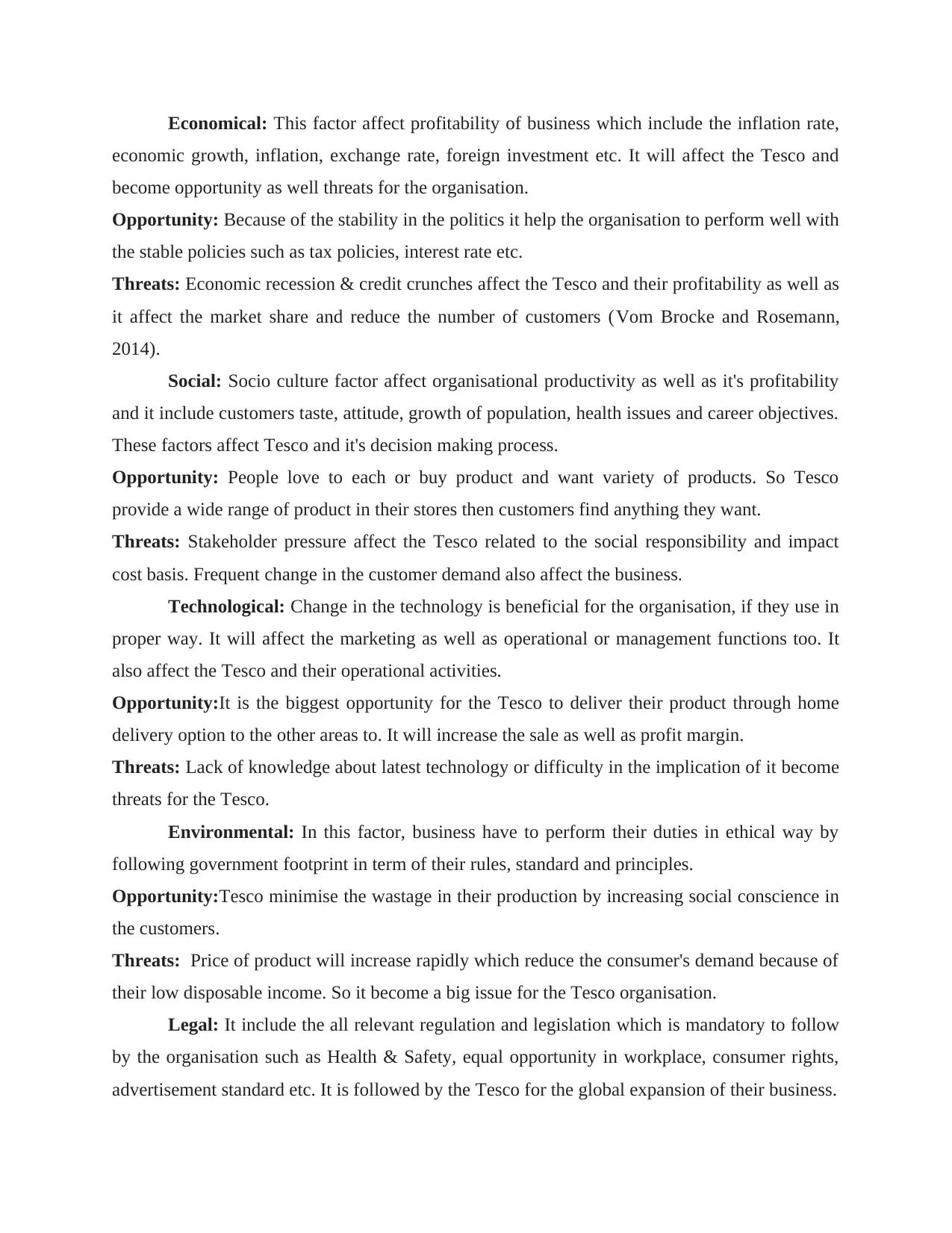
Economical: This factor affect profitability of business which include the inflation rate,
economic growth, inflation, exchange rate, foreign investment etc. It will affect the Tesco and
become opportunity as well threats for the organisation.
Opportunity: Because of the stability in the politics it help the organisation to perform well with
the stable policies such as tax policies, interest rate etc.
Threats: Economic recession & credit crunches affect the Tesco and their profitability as well as
it affect the market share and reduce the number of customers (Vom Brocke and Rosemann,
2014).
Social: Socio culture factor affect organisational productivity as well as it's profitability
and it include customers taste, attitude, growth of population, health issues and career objectives.
These factors affect Tesco and it's decision making process.
Opportunity: People love to each or buy product and want variety of products. So Tesco
provide a wide range of product in their stores then customers find anything they want.
Threats: Stakeholder pressure affect the Tesco related to the social responsibility and impact
cost basis. Frequent change in the customer demand also affect the business.
Technological: Change in the technology is beneficial for the organisation, if they use in
proper way. It will affect the marketing as well as operational or management functions too. It
also affect the Tesco and their operational activities.
Opportunity:It is the biggest opportunity for the Tesco to deliver their product through home
delivery option to the other areas to. It will increase the sale as well as profit margin.
Threats: Lack of knowledge about latest technology or difficulty in the implication of it become
threats for the Tesco.
Environmental: In this factor, business have to perform their duties in ethical way by
following government footprint in term of their rules, standard and principles.
Opportunity:Tesco minimise the wastage in their production by increasing social conscience in
the customers.
Threats: Price of product will increase rapidly which reduce the consumer's demand because of
their low disposable income. So it become a big issue for the Tesco organisation.
Legal: It include the all relevant regulation and legislation which is mandatory to follow
by the organisation such as Health & Safety, equal opportunity in workplace, consumer rights,
advertisement standard etc. It is followed by the Tesco for the global expansion of their business.
economic growth, inflation, exchange rate, foreign investment etc. It will affect the Tesco and
become opportunity as well threats for the organisation.
Opportunity: Because of the stability in the politics it help the organisation to perform well with
the stable policies such as tax policies, interest rate etc.
Threats: Economic recession & credit crunches affect the Tesco and their profitability as well as
it affect the market share and reduce the number of customers (Vom Brocke and Rosemann,
2014).
Social: Socio culture factor affect organisational productivity as well as it's profitability
and it include customers taste, attitude, growth of population, health issues and career objectives.
These factors affect Tesco and it's decision making process.
Opportunity: People love to each or buy product and want variety of products. So Tesco
provide a wide range of product in their stores then customers find anything they want.
Threats: Stakeholder pressure affect the Tesco related to the social responsibility and impact
cost basis. Frequent change in the customer demand also affect the business.
Technological: Change in the technology is beneficial for the organisation, if they use in
proper way. It will affect the marketing as well as operational or management functions too. It
also affect the Tesco and their operational activities.
Opportunity:It is the biggest opportunity for the Tesco to deliver their product through home
delivery option to the other areas to. It will increase the sale as well as profit margin.
Threats: Lack of knowledge about latest technology or difficulty in the implication of it become
threats for the Tesco.
Environmental: In this factor, business have to perform their duties in ethical way by
following government footprint in term of their rules, standard and principles.
Opportunity:Tesco minimise the wastage in their production by increasing social conscience in
the customers.
Threats: Price of product will increase rapidly which reduce the consumer's demand because of
their low disposable income. So it become a big issue for the Tesco organisation.
Legal: It include the all relevant regulation and legislation which is mandatory to follow
by the organisation such as Health & Safety, equal opportunity in workplace, consumer rights,
advertisement standard etc. It is followed by the Tesco for the global expansion of their business.
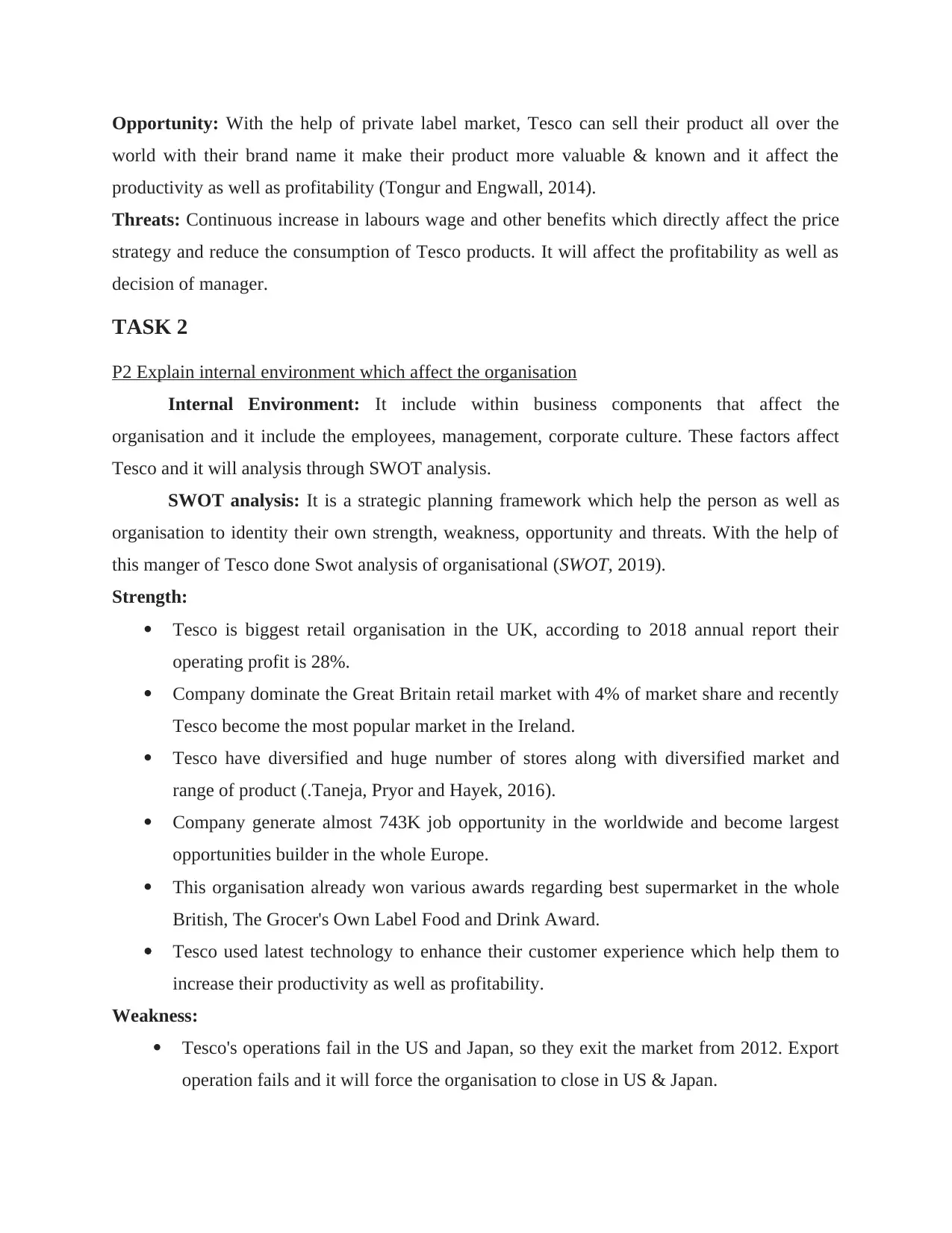
Opportunity: With the help of private label market, Tesco can sell their product all over the
world with their brand name it make their product more valuable & known and it affect the
productivity as well as profitability (Tongur and Engwall, 2014).
Threats: Continuous increase in labours wage and other benefits which directly affect the price
strategy and reduce the consumption of Tesco products. It will affect the profitability as well as
decision of manager.
TASK 2
P2 Explain internal environment which affect the organisation
Internal Environment: It include within business components that affect the
organisation and it include the employees, management, corporate culture. These factors affect
Tesco and it will analysis through SWOT analysis.
SWOT analysis: It is a strategic planning framework which help the person as well as
organisation to identity their own strength, weakness, opportunity and threats. With the help of
this manger of Tesco done Swot analysis of organisational (SWOT, 2019).
Strength:
Tesco is biggest retail organisation in the UK, according to 2018 annual report their
operating profit is 28%.
Company dominate the Great Britain retail market with 4% of market share and recently
Tesco become the most popular market in the Ireland.
Tesco have diversified and huge number of stores along with diversified market and
range of product (.Taneja, Pryor and Hayek, 2016).
Company generate almost 743K job opportunity in the worldwide and become largest
opportunities builder in the whole Europe.
This organisation already won various awards regarding best supermarket in the whole
British, The Grocer's Own Label Food and Drink Award.
Tesco used latest technology to enhance their customer experience which help them to
increase their productivity as well as profitability.
Weakness:
Tesco's operations fail in the US and Japan, so they exit the market from 2012. Export
operation fails and it will force the organisation to close in US & Japan.
world with their brand name it make their product more valuable & known and it affect the
productivity as well as profitability (Tongur and Engwall, 2014).
Threats: Continuous increase in labours wage and other benefits which directly affect the price
strategy and reduce the consumption of Tesco products. It will affect the profitability as well as
decision of manager.
TASK 2
P2 Explain internal environment which affect the organisation
Internal Environment: It include within business components that affect the
organisation and it include the employees, management, corporate culture. These factors affect
Tesco and it will analysis through SWOT analysis.
SWOT analysis: It is a strategic planning framework which help the person as well as
organisation to identity their own strength, weakness, opportunity and threats. With the help of
this manger of Tesco done Swot analysis of organisational (SWOT, 2019).
Strength:
Tesco is biggest retail organisation in the UK, according to 2018 annual report their
operating profit is 28%.
Company dominate the Great Britain retail market with 4% of market share and recently
Tesco become the most popular market in the Ireland.
Tesco have diversified and huge number of stores along with diversified market and
range of product (.Taneja, Pryor and Hayek, 2016).
Company generate almost 743K job opportunity in the worldwide and become largest
opportunities builder in the whole Europe.
This organisation already won various awards regarding best supermarket in the whole
British, The Grocer's Own Label Food and Drink Award.
Tesco used latest technology to enhance their customer experience which help them to
increase their productivity as well as profitability.
Weakness:
Tesco's operations fail in the US and Japan, so they exit the market from 2012. Export
operation fails and it will force the organisation to close in US & Japan.
⊘ This is a preview!⊘
Do you want full access?
Subscribe today to unlock all pages.

Trusted by 1+ million students worldwide
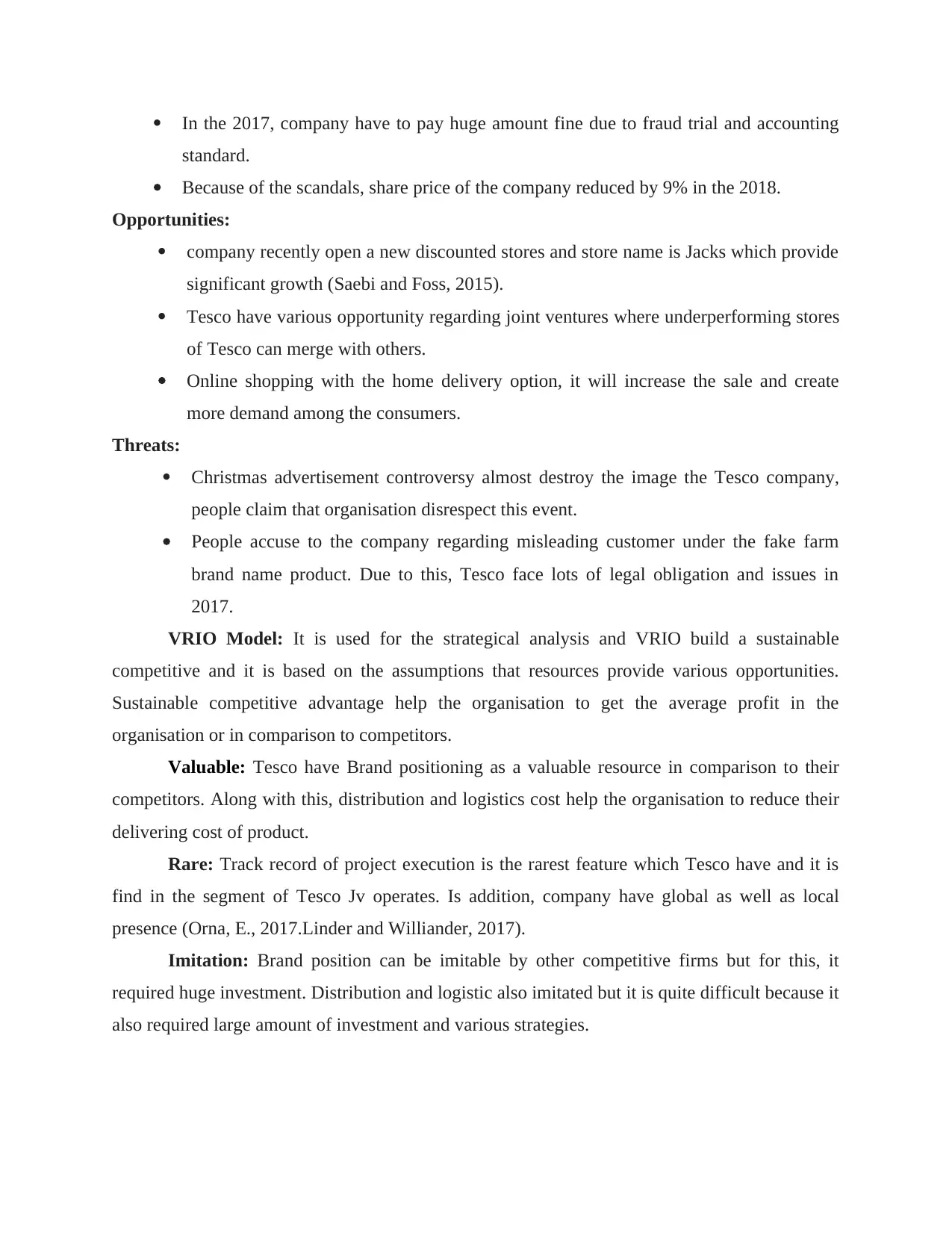
In the 2017, company have to pay huge amount fine due to fraud trial and accounting
standard.
Because of the scandals, share price of the company reduced by 9% in the 2018.
Opportunities:
company recently open a new discounted stores and store name is Jacks which provide
significant growth (Saebi and Foss, 2015).
Tesco have various opportunity regarding joint ventures where underperforming stores
of Tesco can merge with others.
Online shopping with the home delivery option, it will increase the sale and create
more demand among the consumers.
Threats:
Christmas advertisement controversy almost destroy the image the Tesco company,
people claim that organisation disrespect this event.
People accuse to the company regarding misleading customer under the fake farm
brand name product. Due to this, Tesco face lots of legal obligation and issues in
2017.
VRIO Model: It is used for the strategical analysis and VRIO build a sustainable
competitive and it is based on the assumptions that resources provide various opportunities.
Sustainable competitive advantage help the organisation to get the average profit in the
organisation or in comparison to competitors.
Valuable: Tesco have Brand positioning as a valuable resource in comparison to their
competitors. Along with this, distribution and logistics cost help the organisation to reduce their
delivering cost of product.
Rare: Track record of project execution is the rarest feature which Tesco have and it is
find in the segment of Tesco Jv operates. Is addition, company have global as well as local
presence (Orna, E., 2017.Linder and Williander, 2017).
Imitation: Brand position can be imitable by other competitive firms but for this, it
required huge investment. Distribution and logistic also imitated but it is quite difficult because it
also required large amount of investment and various strategies.
standard.
Because of the scandals, share price of the company reduced by 9% in the 2018.
Opportunities:
company recently open a new discounted stores and store name is Jacks which provide
significant growth (Saebi and Foss, 2015).
Tesco have various opportunity regarding joint ventures where underperforming stores
of Tesco can merge with others.
Online shopping with the home delivery option, it will increase the sale and create
more demand among the consumers.
Threats:
Christmas advertisement controversy almost destroy the image the Tesco company,
people claim that organisation disrespect this event.
People accuse to the company regarding misleading customer under the fake farm
brand name product. Due to this, Tesco face lots of legal obligation and issues in
2017.
VRIO Model: It is used for the strategical analysis and VRIO build a sustainable
competitive and it is based on the assumptions that resources provide various opportunities.
Sustainable competitive advantage help the organisation to get the average profit in the
organisation or in comparison to competitors.
Valuable: Tesco have Brand positioning as a valuable resource in comparison to their
competitors. Along with this, distribution and logistics cost help the organisation to reduce their
delivering cost of product.
Rare: Track record of project execution is the rarest feature which Tesco have and it is
find in the segment of Tesco Jv operates. Is addition, company have global as well as local
presence (Orna, E., 2017.Linder and Williander, 2017).
Imitation: Brand position can be imitable by other competitive firms but for this, it
required huge investment. Distribution and logistic also imitated but it is quite difficult because it
also required large amount of investment and various strategies.
Paraphrase This Document
Need a fresh take? Get an instant paraphrase of this document with our AI Paraphraser
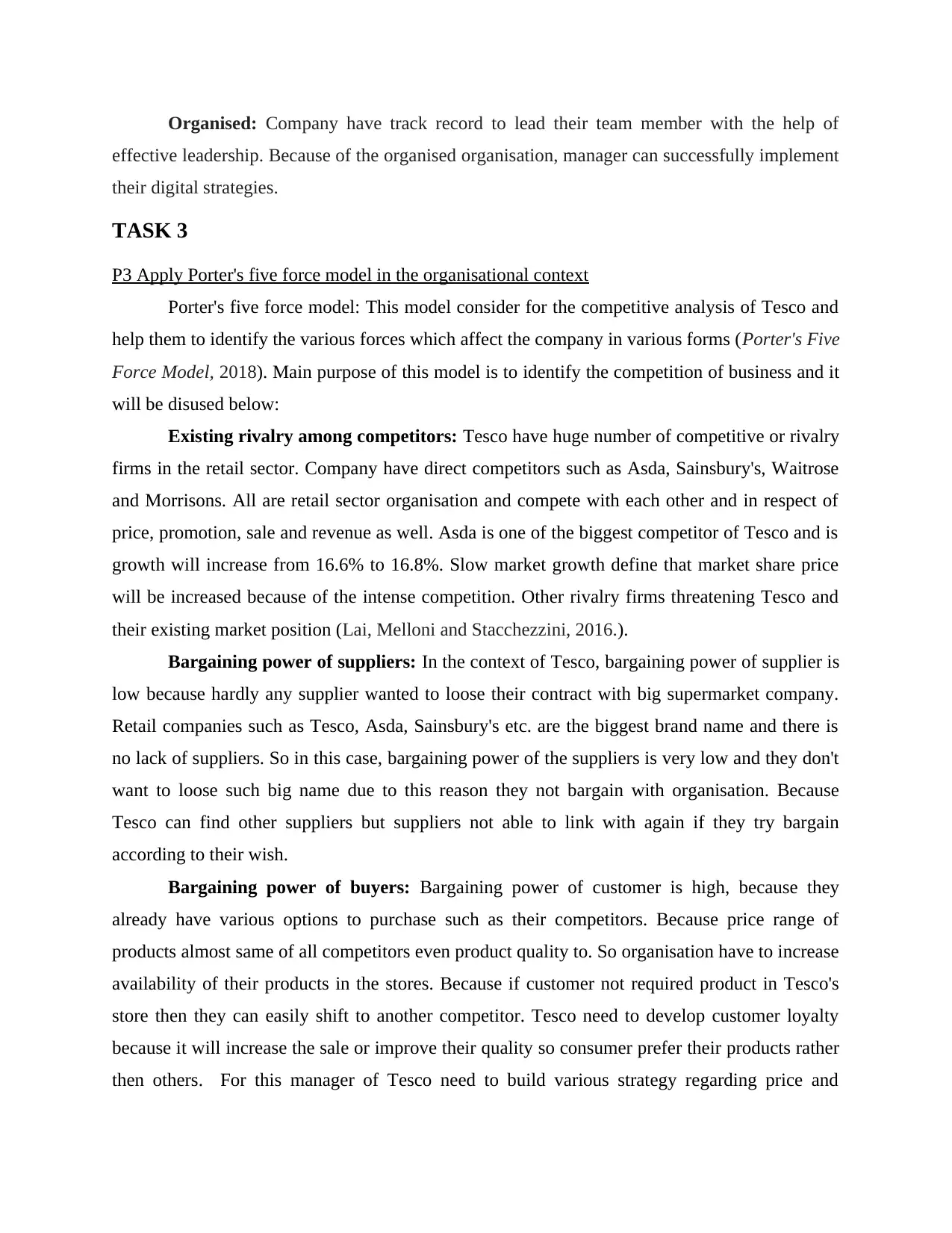
Organised: Company have track record to lead their team member with the help of
effective leadership. Because of the organised organisation, manager can successfully implement
their digital strategies.
TASK 3
P3 Apply Porter's five force model in the organisational context
Porter's five force model: This model consider for the competitive analysis of Tesco and
help them to identify the various forces which affect the company in various forms (Porter's Five
Force Model, 2018). Main purpose of this model is to identify the competition of business and it
will be disused below:
Existing rivalry among competitors: Tesco have huge number of competitive or rivalry
firms in the retail sector. Company have direct competitors such as Asda, Sainsbury's, Waitrose
and Morrisons. All are retail sector organisation and compete with each other and in respect of
price, promotion, sale and revenue as well. Asda is one of the biggest competitor of Tesco and is
growth will increase from 16.6% to 16.8%. Slow market growth define that market share price
will be increased because of the intense competition. Other rivalry firms threatening Tesco and
their existing market position (Lai, Melloni and Stacchezzini, 2016.).
Bargaining power of suppliers: In the context of Tesco, bargaining power of supplier is
low because hardly any supplier wanted to loose their contract with big supermarket company.
Retail companies such as Tesco, Asda, Sainsbury's etc. are the biggest brand name and there is
no lack of suppliers. So in this case, bargaining power of the suppliers is very low and they don't
want to loose such big name due to this reason they not bargain with organisation. Because
Tesco can find other suppliers but suppliers not able to link with again if they try bargain
according to their wish.
Bargaining power of buyers: Bargaining power of customer is high, because they
already have various options to purchase such as their competitors. Because price range of
products almost same of all competitors even product quality to. So organisation have to increase
availability of their products in the stores. Because if customer not required product in Tesco's
store then they can easily shift to another competitor. Tesco need to develop customer loyalty
because it will increase the sale or improve their quality so consumer prefer their products rather
then others. For this manager of Tesco need to build various strategy regarding price and
effective leadership. Because of the organised organisation, manager can successfully implement
their digital strategies.
TASK 3
P3 Apply Porter's five force model in the organisational context
Porter's five force model: This model consider for the competitive analysis of Tesco and
help them to identify the various forces which affect the company in various forms (Porter's Five
Force Model, 2018). Main purpose of this model is to identify the competition of business and it
will be disused below:
Existing rivalry among competitors: Tesco have huge number of competitive or rivalry
firms in the retail sector. Company have direct competitors such as Asda, Sainsbury's, Waitrose
and Morrisons. All are retail sector organisation and compete with each other and in respect of
price, promotion, sale and revenue as well. Asda is one of the biggest competitor of Tesco and is
growth will increase from 16.6% to 16.8%. Slow market growth define that market share price
will be increased because of the intense competition. Other rivalry firms threatening Tesco and
their existing market position (Lai, Melloni and Stacchezzini, 2016.).
Bargaining power of suppliers: In the context of Tesco, bargaining power of supplier is
low because hardly any supplier wanted to loose their contract with big supermarket company.
Retail companies such as Tesco, Asda, Sainsbury's etc. are the biggest brand name and there is
no lack of suppliers. So in this case, bargaining power of the suppliers is very low and they don't
want to loose such big name due to this reason they not bargain with organisation. Because
Tesco can find other suppliers but suppliers not able to link with again if they try bargain
according to their wish.
Bargaining power of buyers: Bargaining power of customer is high, because they
already have various options to purchase such as their competitors. Because price range of
products almost same of all competitors even product quality to. So organisation have to increase
availability of their products in the stores. Because if customer not required product in Tesco's
store then they can easily shift to another competitor. Tesco need to develop customer loyalty
because it will increase the sale or improve their quality so consumer prefer their products rather
then others. For this manager of Tesco need to build various strategy regarding price and
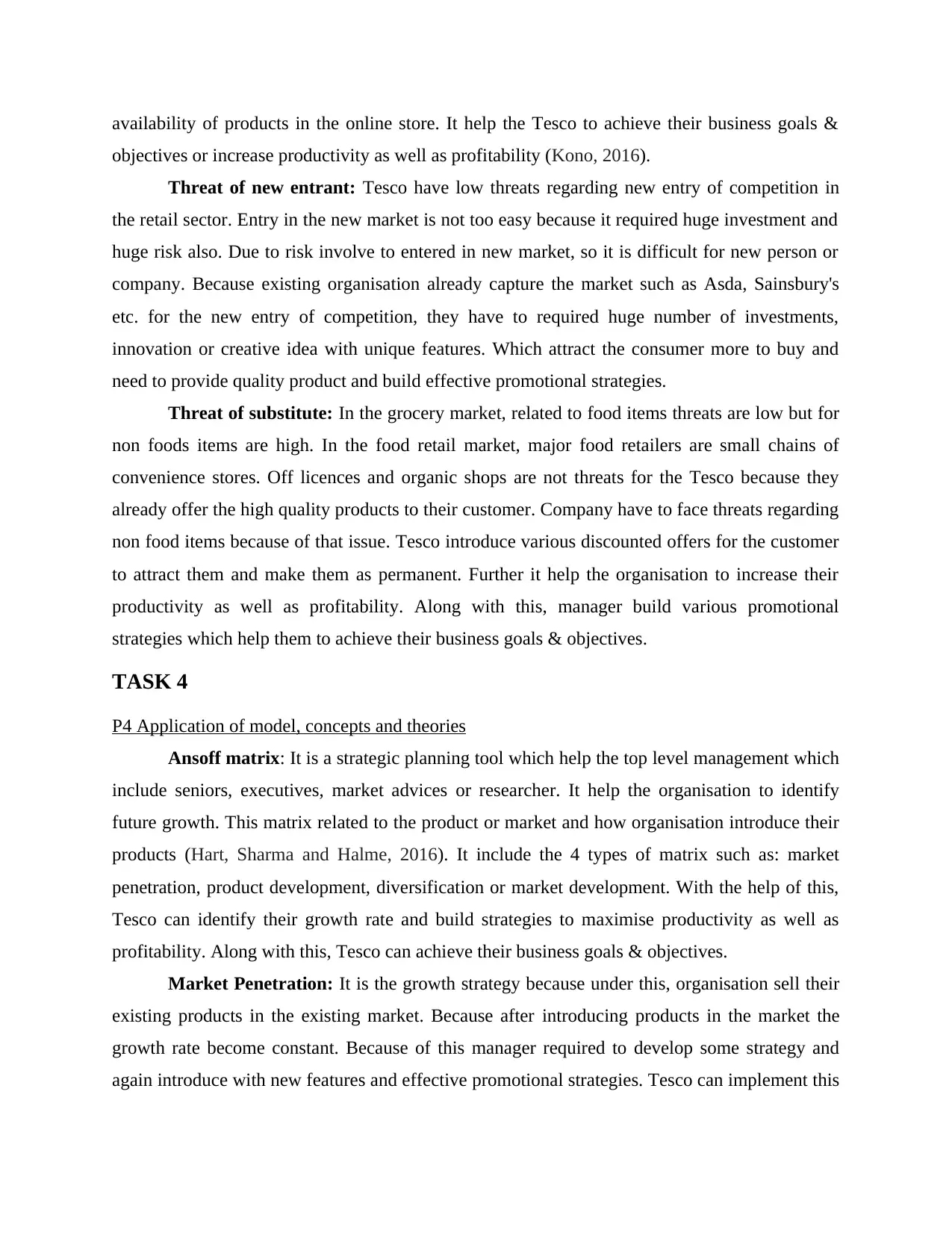
availability of products in the online store. It help the Tesco to achieve their business goals &
objectives or increase productivity as well as profitability (Kono, 2016).
Threat of new entrant: Tesco have low threats regarding new entry of competition in
the retail sector. Entry in the new market is not too easy because it required huge investment and
huge risk also. Due to risk involve to entered in new market, so it is difficult for new person or
company. Because existing organisation already capture the market such as Asda, Sainsbury's
etc. for the new entry of competition, they have to required huge number of investments,
innovation or creative idea with unique features. Which attract the consumer more to buy and
need to provide quality product and build effective promotional strategies.
Threat of substitute: In the grocery market, related to food items threats are low but for
non foods items are high. In the food retail market, major food retailers are small chains of
convenience stores. Off licences and organic shops are not threats for the Tesco because they
already offer the high quality products to their customer. Company have to face threats regarding
non food items because of that issue. Tesco introduce various discounted offers for the customer
to attract them and make them as permanent. Further it help the organisation to increase their
productivity as well as profitability. Along with this, manager build various promotional
strategies which help them to achieve their business goals & objectives.
TASK 4
P4 Application of model, concepts and theories
Ansoff matrix: It is a strategic planning tool which help the top level management which
include seniors, executives, market advices or researcher. It help the organisation to identify
future growth. This matrix related to the product or market and how organisation introduce their
products (Hart, Sharma and Halme, 2016). It include the 4 types of matrix such as: market
penetration, product development, diversification or market development. With the help of this,
Tesco can identify their growth rate and build strategies to maximise productivity as well as
profitability. Along with this, Tesco can achieve their business goals & objectives.
Market Penetration: It is the growth strategy because under this, organisation sell their
existing products in the existing market. Because after introducing products in the market the
growth rate become constant. Because of this manager required to develop some strategy and
again introduce with new features and effective promotional strategies. Tesco can implement this
objectives or increase productivity as well as profitability (Kono, 2016).
Threat of new entrant: Tesco have low threats regarding new entry of competition in
the retail sector. Entry in the new market is not too easy because it required huge investment and
huge risk also. Due to risk involve to entered in new market, so it is difficult for new person or
company. Because existing organisation already capture the market such as Asda, Sainsbury's
etc. for the new entry of competition, they have to required huge number of investments,
innovation or creative idea with unique features. Which attract the consumer more to buy and
need to provide quality product and build effective promotional strategies.
Threat of substitute: In the grocery market, related to food items threats are low but for
non foods items are high. In the food retail market, major food retailers are small chains of
convenience stores. Off licences and organic shops are not threats for the Tesco because they
already offer the high quality products to their customer. Company have to face threats regarding
non food items because of that issue. Tesco introduce various discounted offers for the customer
to attract them and make them as permanent. Further it help the organisation to increase their
productivity as well as profitability. Along with this, manager build various promotional
strategies which help them to achieve their business goals & objectives.
TASK 4
P4 Application of model, concepts and theories
Ansoff matrix: It is a strategic planning tool which help the top level management which
include seniors, executives, market advices or researcher. It help the organisation to identify
future growth. This matrix related to the product or market and how organisation introduce their
products (Hart, Sharma and Halme, 2016). It include the 4 types of matrix such as: market
penetration, product development, diversification or market development. With the help of this,
Tesco can identify their growth rate and build strategies to maximise productivity as well as
profitability. Along with this, Tesco can achieve their business goals & objectives.
Market Penetration: It is the growth strategy because under this, organisation sell their
existing products in the existing market. Because after introducing products in the market the
growth rate become constant. Because of this manager required to develop some strategy and
again introduce with new features and effective promotional strategies. Tesco can implement this
⊘ This is a preview!⊘
Do you want full access?
Subscribe today to unlock all pages.

Trusted by 1+ million students worldwide
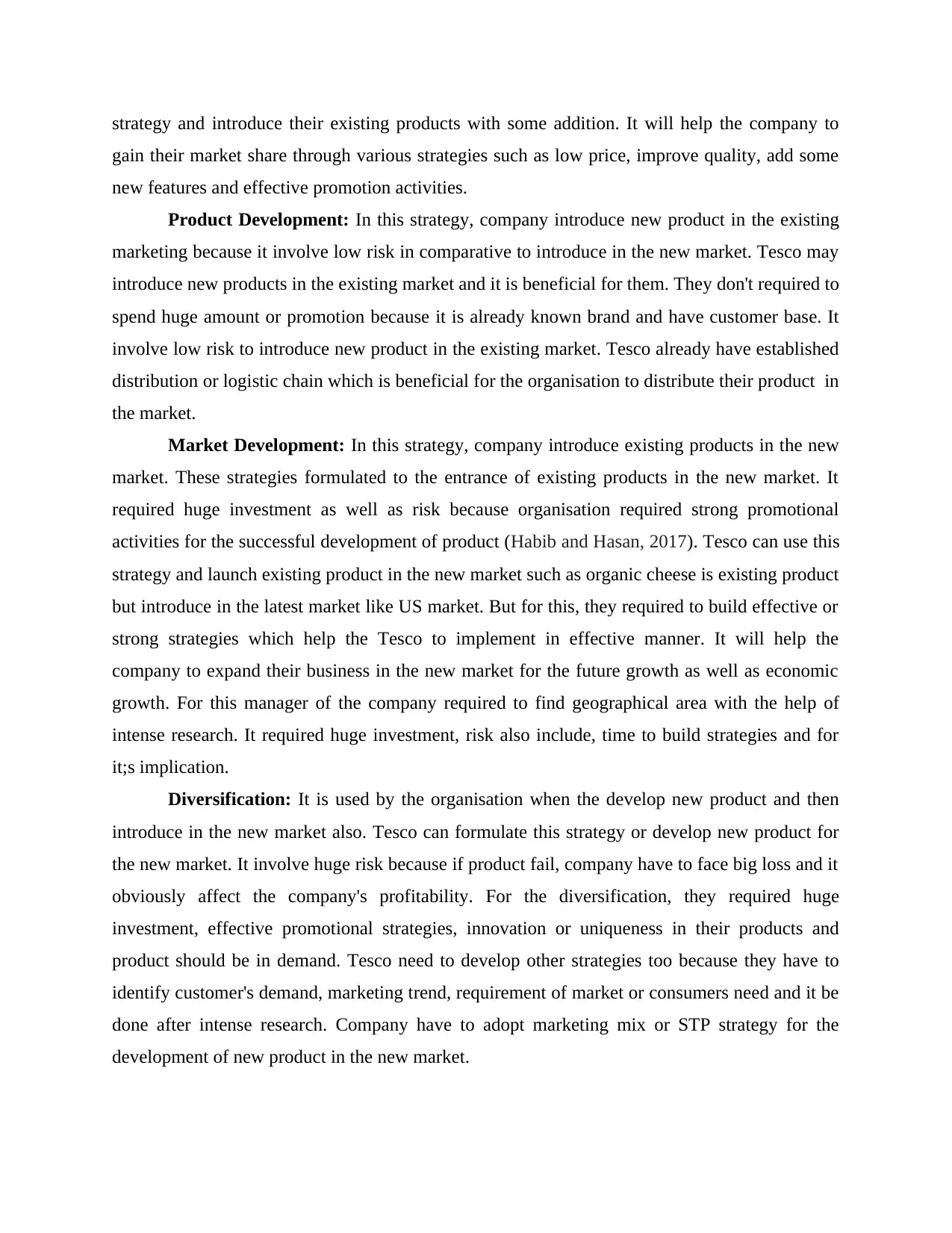
strategy and introduce their existing products with some addition. It will help the company to
gain their market share through various strategies such as low price, improve quality, add some
new features and effective promotion activities.
Product Development: In this strategy, company introduce new product in the existing
marketing because it involve low risk in comparative to introduce in the new market. Tesco may
introduce new products in the existing market and it is beneficial for them. They don't required to
spend huge amount or promotion because it is already known brand and have customer base. It
involve low risk to introduce new product in the existing market. Tesco already have established
distribution or logistic chain which is beneficial for the organisation to distribute their product in
the market.
Market Development: In this strategy, company introduce existing products in the new
market. These strategies formulated to the entrance of existing products in the new market. It
required huge investment as well as risk because organisation required strong promotional
activities for the successful development of product (Habib and Hasan, 2017). Tesco can use this
strategy and launch existing product in the new market such as organic cheese is existing product
but introduce in the latest market like US market. But for this, they required to build effective or
strong strategies which help the Tesco to implement in effective manner. It will help the
company to expand their business in the new market for the future growth as well as economic
growth. For this manager of the company required to find geographical area with the help of
intense research. It required huge investment, risk also include, time to build strategies and for
it;s implication.
Diversification: It is used by the organisation when the develop new product and then
introduce in the new market also. Tesco can formulate this strategy or develop new product for
the new market. It involve huge risk because if product fail, company have to face big loss and it
obviously affect the company's profitability. For the diversification, they required huge
investment, effective promotional strategies, innovation or uniqueness in their products and
product should be in demand. Tesco need to develop other strategies too because they have to
identify customer's demand, marketing trend, requirement of market or consumers need and it be
done after intense research. Company have to adopt marketing mix or STP strategy for the
development of new product in the new market.
gain their market share through various strategies such as low price, improve quality, add some
new features and effective promotion activities.
Product Development: In this strategy, company introduce new product in the existing
marketing because it involve low risk in comparative to introduce in the new market. Tesco may
introduce new products in the existing market and it is beneficial for them. They don't required to
spend huge amount or promotion because it is already known brand and have customer base. It
involve low risk to introduce new product in the existing market. Tesco already have established
distribution or logistic chain which is beneficial for the organisation to distribute their product in
the market.
Market Development: In this strategy, company introduce existing products in the new
market. These strategies formulated to the entrance of existing products in the new market. It
required huge investment as well as risk because organisation required strong promotional
activities for the successful development of product (Habib and Hasan, 2017). Tesco can use this
strategy and launch existing product in the new market such as organic cheese is existing product
but introduce in the latest market like US market. But for this, they required to build effective or
strong strategies which help the Tesco to implement in effective manner. It will help the
company to expand their business in the new market for the future growth as well as economic
growth. For this manager of the company required to find geographical area with the help of
intense research. It required huge investment, risk also include, time to build strategies and for
it;s implication.
Diversification: It is used by the organisation when the develop new product and then
introduce in the new market also. Tesco can formulate this strategy or develop new product for
the new market. It involve huge risk because if product fail, company have to face big loss and it
obviously affect the company's profitability. For the diversification, they required huge
investment, effective promotional strategies, innovation or uniqueness in their products and
product should be in demand. Tesco need to develop other strategies too because they have to
identify customer's demand, marketing trend, requirement of market or consumers need and it be
done after intense research. Company have to adopt marketing mix or STP strategy for the
development of new product in the new market.
Paraphrase This Document
Need a fresh take? Get an instant paraphrase of this document with our AI Paraphraser
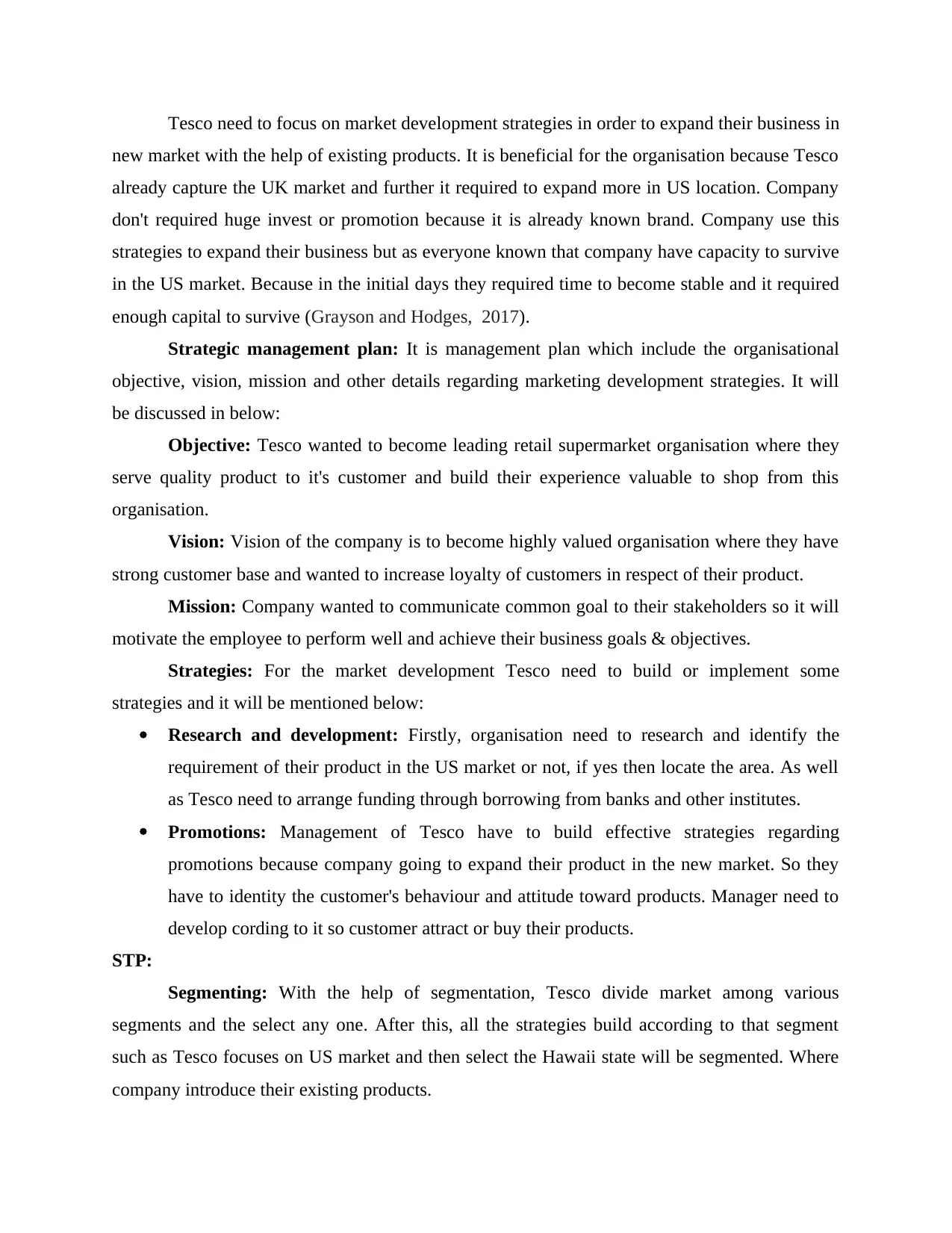
Tesco need to focus on market development strategies in order to expand their business in
new market with the help of existing products. It is beneficial for the organisation because Tesco
already capture the UK market and further it required to expand more in US location. Company
don't required huge invest or promotion because it is already known brand. Company use this
strategies to expand their business but as everyone known that company have capacity to survive
in the US market. Because in the initial days they required time to become stable and it required
enough capital to survive (Grayson and Hodges, 2017).
Strategic management plan: It is management plan which include the organisational
objective, vision, mission and other details regarding marketing development strategies. It will
be discussed in below:
Objective: Tesco wanted to become leading retail supermarket organisation where they
serve quality product to it's customer and build their experience valuable to shop from this
organisation.
Vision: Vision of the company is to become highly valued organisation where they have
strong customer base and wanted to increase loyalty of customers in respect of their product.
Mission: Company wanted to communicate common goal to their stakeholders so it will
motivate the employee to perform well and achieve their business goals & objectives.
Strategies: For the market development Tesco need to build or implement some
strategies and it will be mentioned below:
Research and development: Firstly, organisation need to research and identify the
requirement of their product in the US market or not, if yes then locate the area. As well
as Tesco need to arrange funding through borrowing from banks and other institutes.
Promotions: Management of Tesco have to build effective strategies regarding
promotions because company going to expand their product in the new market. So they
have to identity the customer's behaviour and attitude toward products. Manager need to
develop cording to it so customer attract or buy their products.
STP:
Segmenting: With the help of segmentation, Tesco divide market among various
segments and the select any one. After this, all the strategies build according to that segment
such as Tesco focuses on US market and then select the Hawaii state will be segmented. Where
company introduce their existing products.
new market with the help of existing products. It is beneficial for the organisation because Tesco
already capture the UK market and further it required to expand more in US location. Company
don't required huge invest or promotion because it is already known brand. Company use this
strategies to expand their business but as everyone known that company have capacity to survive
in the US market. Because in the initial days they required time to become stable and it required
enough capital to survive (Grayson and Hodges, 2017).
Strategic management plan: It is management plan which include the organisational
objective, vision, mission and other details regarding marketing development strategies. It will
be discussed in below:
Objective: Tesco wanted to become leading retail supermarket organisation where they
serve quality product to it's customer and build their experience valuable to shop from this
organisation.
Vision: Vision of the company is to become highly valued organisation where they have
strong customer base and wanted to increase loyalty of customers in respect of their product.
Mission: Company wanted to communicate common goal to their stakeholders so it will
motivate the employee to perform well and achieve their business goals & objectives.
Strategies: For the market development Tesco need to build or implement some
strategies and it will be mentioned below:
Research and development: Firstly, organisation need to research and identify the
requirement of their product in the US market or not, if yes then locate the area. As well
as Tesco need to arrange funding through borrowing from banks and other institutes.
Promotions: Management of Tesco have to build effective strategies regarding
promotions because company going to expand their product in the new market. So they
have to identity the customer's behaviour and attitude toward products. Manager need to
develop cording to it so customer attract or buy their products.
STP:
Segmenting: With the help of segmentation, Tesco divide market among various
segments and the select any one. After this, all the strategies build according to that segment
such as Tesco focuses on US market and then select the Hawaii state will be segmented. Where
company introduce their existing products.
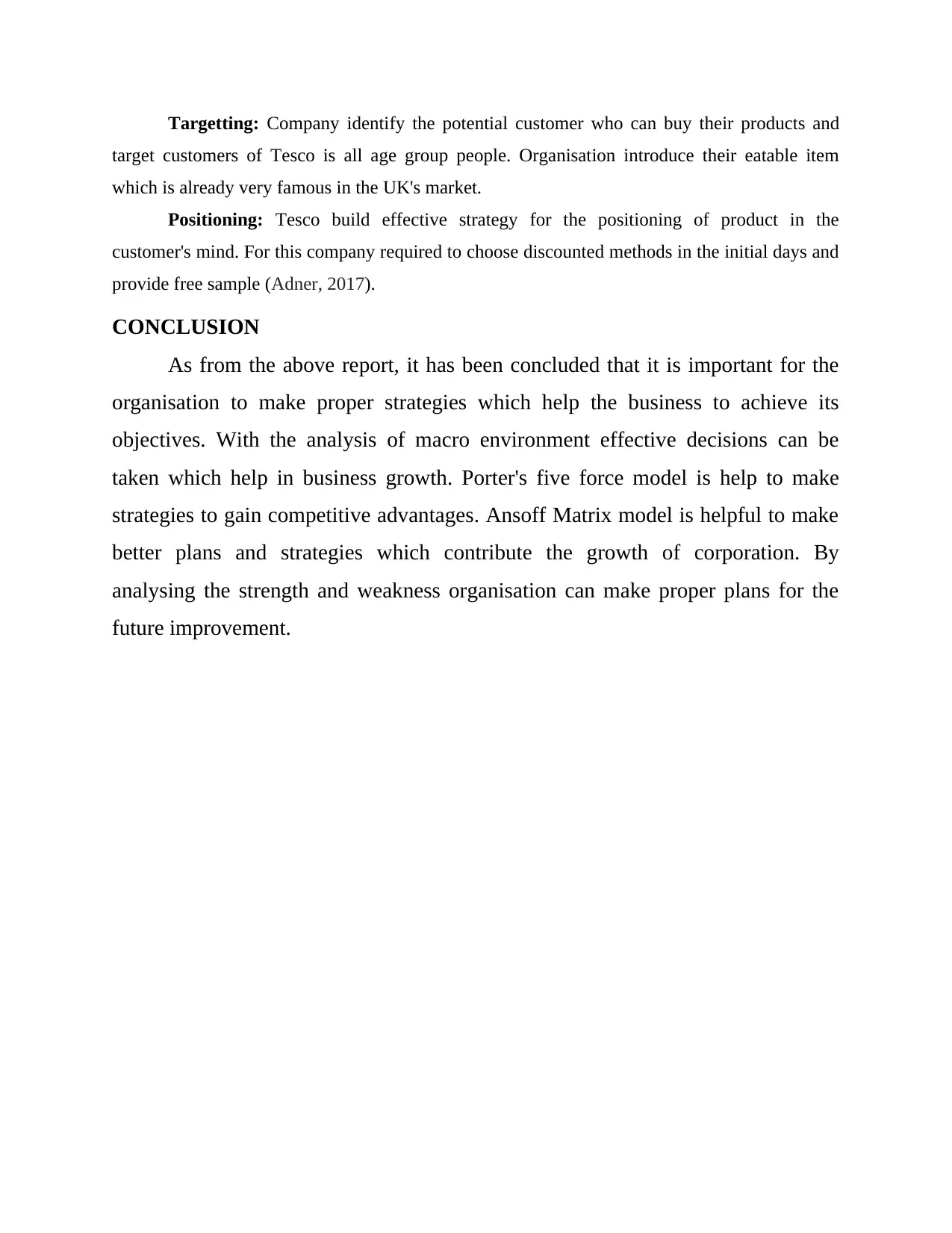
Targetting: Company identify the potential customer who can buy their products and
target customers of Tesco is all age group people. Organisation introduce their eatable item
which is already very famous in the UK's market.
Positioning: Tesco build effective strategy for the positioning of product in the
customer's mind. For this company required to choose discounted methods in the initial days and
provide free sample (Adner, 2017).
CONCLUSION
As from the above report, it has been concluded that it is important for the
organisation to make proper strategies which help the business to achieve its
objectives. With the analysis of macro environment effective decisions can be
taken which help in business growth. Porter's five force model is help to make
strategies to gain competitive advantages. Ansoff Matrix model is helpful to make
better plans and strategies which contribute the growth of corporation. By
analysing the strength and weakness organisation can make proper plans for the
future improvement.
target customers of Tesco is all age group people. Organisation introduce their eatable item
which is already very famous in the UK's market.
Positioning: Tesco build effective strategy for the positioning of product in the
customer's mind. For this company required to choose discounted methods in the initial days and
provide free sample (Adner, 2017).
CONCLUSION
As from the above report, it has been concluded that it is important for the
organisation to make proper strategies which help the business to achieve its
objectives. With the analysis of macro environment effective decisions can be
taken which help in business growth. Porter's five force model is help to make
strategies to gain competitive advantages. Ansoff Matrix model is helpful to make
better plans and strategies which contribute the growth of corporation. By
analysing the strength and weakness organisation can make proper plans for the
future improvement.
⊘ This is a preview!⊘
Do you want full access?
Subscribe today to unlock all pages.

Trusted by 1+ million students worldwide
1 out of 13
Related Documents
Your All-in-One AI-Powered Toolkit for Academic Success.
+13062052269
info@desklib.com
Available 24*7 on WhatsApp / Email
![[object Object]](/_next/static/media/star-bottom.7253800d.svg)
Unlock your academic potential
Copyright © 2020–2026 A2Z Services. All Rights Reserved. Developed and managed by ZUCOL.




